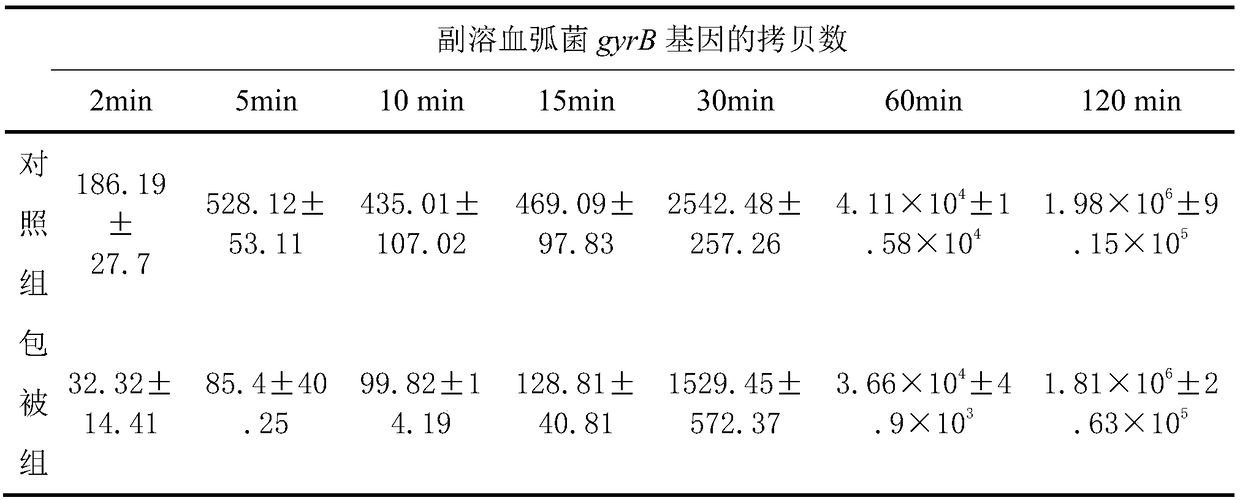Fish-derived vibrio parahaemolyticus controlled-release oral vaccine and preparation and utilization method
A technology of Vibrio hemolyticus and oral vaccine, which is applied to the vaccine and application field of farmed fish, can solve the problems of complex microsphere vaccine process, difficult to popularize and apply on a large scale, low content of outer membrane protein, etc., and achieves high market application value, Overcome ineffective, easy-to-use effects
- Summary
- Abstract
- Description
- Claims
- Application Information
AI Technical Summary
Problems solved by technology
Method used
Image
Examples
preparation example Construction
[0036] The preparation of fish source Vibrio parahaemolyticus slow-release oral vaccine, the method of this preparation process is as follows:
[0037] (1) Inactivation: Use 0.5% formaldehyde to inactivate the Vibrio parahaemolyticus liquid;
[0038] ⑵ Vaccine preparation:
[0039] According to commercial feed: the concentration is 6×10 10 The Vibrio parahaemolyticus ratio of cfu / mL is: 10:1, and the unit is: gram:mL. Put the commercialized feed into the coating machine, start the turntable, and the pellet machine adopts a rotating speed of 400 rpm to inactivate The Vibrio parahaemolyticus vaccine is slowly dripped into the center of the turntable, and the vaccine is sprayed onto the feed by the centrifugal force of the central turntable to prepare vaccine feed. The effective concentration of the vaccine is about 6×10 9 cfu / g feed, put it into an oven for drying at 37°C for later use.
[0040] ⑶ Sustained release layer coating preparation:
[0041] 1. Sustained-release age...
example 1
[0049] The vaccine feed prepared above is used to immunize turbot, and the specification of turbot is 102±11.2 grams. The amount of feeding was the same as that of normal bait. Normal bait was fed for 7 consecutive days, with an interval of 14 days to boost immunity for 7 days.
[0050] In the experiment of immunizing turbot in small water body of aquarium, two groups were designed, the control group and the slow-release oral immunization group, with 3 repetitions in each group. The slow-release oral immunization group was fed the prepared slow-release oral vaccine twice a day for 7 consecutive days, and then fed normal bait; the control group was fed normal granule bait. Blood was collected once every 7 days, and three fish were collected in each group, and the antibody level in the serum was measured by enzyme-linked immunosorbent assay (Elisa). After 28 days, test fish and control fish were subjected to Vibrio parahaemolyticus (concentration of bacteria liquid was 3×10 8 ...
example 2
[0055] Workshop breeding test:
[0056] Breeding mode: factory farming; farmed fish: flounder, size 89±15.2 grams; a total of 6 test ponds, including 3 test ponds and 3 control ponds. First immunization: feed twice a day for 7 consecutive days; booster immunization: 21 days after the first immunization, feed twice a day for 7 days. The control pond was fed with common bait, and the other breeding and management methods were the same. After 2 months, the serum of 5 fish was collected from each pond, and the antibody titer was determined by agglutination method, and 50 flounder were collected for Vibrio parahaemolyticus (the concentration of bacteria solution was 3×10 8 cfu / mL) in the artificial infection experiment, each fish was injected with 0.2 mL, the mortality within 14 days was counted, and the immune protection rate was calculated. The test results are shown in Table 3.
[0057] Table 3 Serum antibody titer and immune protection rate of flounder
[0058]
[0059] ...
PUM
 Login to View More
Login to View More Abstract
Description
Claims
Application Information
 Login to View More
Login to View More - R&D Engineer
- R&D Manager
- IP Professional
- Industry Leading Data Capabilities
- Powerful AI technology
- Patent DNA Extraction
Browse by: Latest US Patents, China's latest patents, Technical Efficacy Thesaurus, Application Domain, Technology Topic, Popular Technical Reports.
© 2024 PatSnap. All rights reserved.Legal|Privacy policy|Modern Slavery Act Transparency Statement|Sitemap|About US| Contact US: help@patsnap.com










